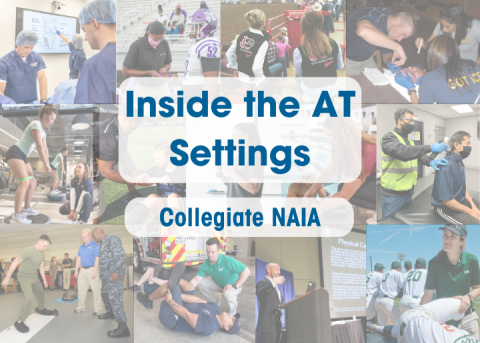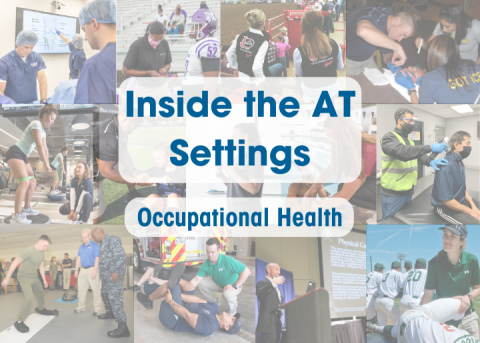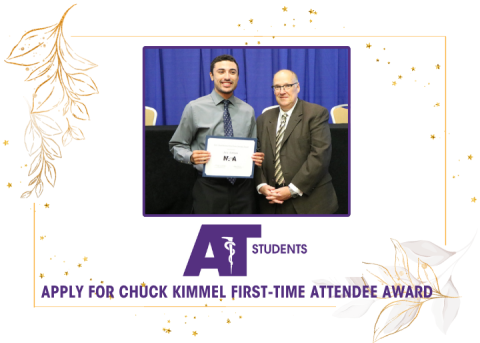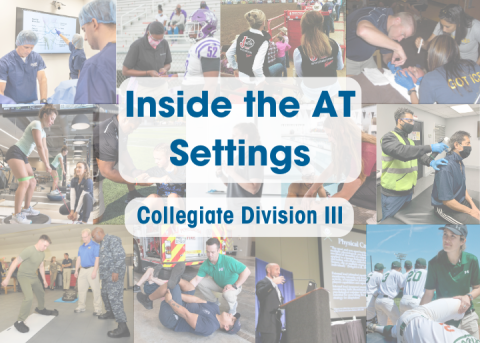February 24, 2016 by Todd Christman
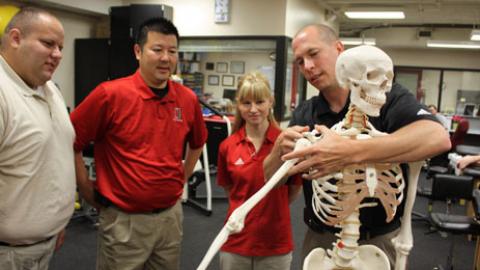
By Jeremy Hawkins, PhD, ATC, ATP Director, Colorado Mesa University
Both as an educator and as a clinician I have heard something like the following at least once in every semester, “I don’t want to do ________. It is so boring. I don’t get to do anything there.” You can fill in the blank with any number of clinical assignments and adjust the last two sentences in a myriad of ways to essentially say the same thing in a different way. Over the years I have gained a greater appreciation of what each clinical assignment has to offer and the role they play in the educational pursuits of an athletic training student. It is from this perspective that I would like to share with you five suggestions1 that may help you look at your clinical assignment differently.
1. Why are you there? If you are at your clinical assignment to be entertained you will most likely be disappointed. As an undergraduate student I had the opportunity to be on the sidelines in Lavell Edwards Stadium and to visit the likes of Cal’s Memorial Stadium, War Memorial Stadium in Laramie, Wyoming (the highest stadium in elevation in Division I football), and Stanford’s Klein Field at Sunken Diamond. Did those experiences make up for hours out in the sun, rain, snow and wind? No. They are good memories, but they are just that, memories. It was the time put in at practice, and before and after practice, that helped me to become an athletic trainer. The purpose of any clinical assignment is to change you—to change how you see and do things. Approach them from that mindset.
2. Lighting a fire. William Butler Yeats once said, “Education is not the filling of a pail, but the lighting of a fire.” Recognizing that not everyone who may be reading this has lit a fire before, I would like to review some basic steps. You would most likely begin with dry kindling (easily combustible small sticks or twigs used for starting a fire) that you light with a match or other ignition source. Once your kindling is lit you will add larger pieces of wood to build the fire. The more wood you add, the longer and/or hotter your fire will burn. So what does that have to do with a clinical assignment? You have to be prepared for your clinical assignment in order for that assignment to ignite you and keep you burning. And the fire associated with that clinical assignment must be continuously fed for it to stay burning. We all have off days, but if a given day is not what you hoped, consider the state of the kindling you showed up with that day. Wet kindling takes a lot of effort to get burning.
3. Take it personally. At the end of the day, learning is a personal thing. As educators we can do our best to teach, but you have to choose to learn. Learning happens as you make connections between what you are taught and your personal life. Think about what you saw/participated in at your clinical assignment and how that is helping you become an athletic trainer. Share your experiences with others and ask questions. Be invested in your learning and the return on your investment will increase.
4. Look for diamonds. One of my fondest memories during my career as a full time teacher happened the first semester as a full time teacher. I was working with a group of athletic training students in their first semester in the athletic training program. We were practicing knee special tests. As many can attest to, learning how to correctly perform a Lachman’s test can be particularly problematic. I can still clearly remember the look on the face of one of the athletic training students when she did it correctly. She was so excited! That was a diamond for her that day (and one for me too). There are diamonds like that in all we do as athletic trainers, if we are looking for them. Perhaps it is doing your first full evaluation or watching someone progress with their rehab or being cleared from a concussion. These experiences can be meaningful to you and your progression towards becoming an athletic trainer. Find them. And once you find them, share them with others. You may inspire them to look for their own diamonds.
5. Take it with you. In the grand scheme of things, if the only time you spend making what you are learning clinically yours is while you are at your clinical assignment, you are selling yourself short. Continue to think about what you experienced, using it to guide further study and inquiry. Doing so can lead to rich experiences for you.
In conclusion, the benefits of what you get out of your clinical assignment have as much to do with what you do before and after as it does with what you are doing while there. As educators we try to do our best to put you in situations wherein you can grow and develop. Make the most of those experiences by choosing to do so.
References 1. Barnes T. How to Never Have a Boring Church Class Again. Available at https://www.lds.org/youth/article/how-to-never-have-a-boring-church-class-again?lang=eng. Accessed February 18, 2016.
Both as an educator and as a clinician I have heard something like the following at least once in every semester, “I don’t want to do ________. It is so boring. I don’t get to do anything there.” You can fill in the blank with any number of clinical assignments and adjust the last two sentences in a myriad of ways to essentially say the same thing in a different way. Over the years I have gained a greater appreciation of what each clinical assignment has to offer and the role they play in the educational pursuits of an athletic training student. It is from this perspective that I would like to share with you five suggestions1 that may help you look at your clinical assignment differently.
1. Why are you there? If you are at your clinical assignment to be entertained you will most likely be disappointed. As an undergraduate student I had the opportunity to be on the sidelines in Lavell Edwards Stadium and to visit the likes of Cal’s Memorial Stadium, War Memorial Stadium in Laramie, Wyoming (the highest stadium in elevation in Division I football), and Stanford’s Klein Field at Sunken Diamond. Did those experiences make up for hours out in the sun, rain, snow and wind? No. They are good memories, but they are just that, memories. It was the time put in at practice, and before and after practice, that helped me to become an athletic trainer. The purpose of any clinical assignment is to change you—to change how you see and do things. Approach them from that mindset.
2. Lighting a fire. William Butler Yeats once said, “Education is not the filling of a pail, but the lighting of a fire.” Recognizing that not everyone who may be reading this has lit a fire before, I would like to review some basic steps. You would most likely begin with dry kindling (easily combustible small sticks or twigs used for starting a fire) that you light with a match or other ignition source. Once your kindling is lit you will add larger pieces of wood to build the fire. The more wood you add, the longer and/or hotter your fire will burn. So what does that have to do with a clinical assignment? You have to be prepared for your clinical assignment in order for that assignment to ignite you and keep you burning. And the fire associated with that clinical assignment must be continuously fed for it to stay burning. We all have off days, but if a given day is not what you hoped, consider the state of the kindling you showed up with that day. Wet kindling takes a lot of effort to get burning.
3. Take it personally. At the end of the day, learning is a personal thing. As educators we can do our best to teach, but you have to choose to learn. Learning happens as you make connections between what you are taught and your personal life. Think about what you saw/participated in at your clinical assignment and how that is helping you become an athletic trainer. Share your experiences with others and ask questions. Be invested in your learning and the return on your investment will increase.
4. Look for diamonds. One of my fondest memories during my career as a full time teacher happened the first semester as a full time teacher. I was working with a group of athletic training students in their first semester in the athletic training program. We were practicing knee special tests. As many can attest to, learning how to correctly perform a Lachman’s test can be particularly problematic. I can still clearly remember the look on the face of one of the athletic training students when she did it correctly. She was so excited! That was a diamond for her that day (and one for me too). There are diamonds like that in all we do as athletic trainers, if we are looking for them. Perhaps it is doing your first full evaluation or watching someone progress with their rehab or being cleared from a concussion. These experiences can be meaningful to you and your progression towards becoming an athletic trainer. Find them. And once you find them, share them with others. You may inspire them to look for their own diamonds.
5. Take it with you. In the grand scheme of things, if the only time you spend making what you are learning clinically yours is while you are at your clinical assignment, you are selling yourself short. Continue to think about what you experienced, using it to guide further study and inquiry. Doing so can lead to rich experiences for you.
In conclusion, the benefits of what you get out of your clinical assignment have as much to do with what you do before and after as it does with what you are doing while there. As educators we try to do our best to put you in situations wherein you can grow and develop. Make the most of those experiences by choosing to do so.
References 1. Barnes T. How to Never Have a Boring Church Class Again. Available at https://www.lds.org/youth/article/how-to-never-have-a-boring-church-class-again?lang=eng. Accessed February 18, 2016.


